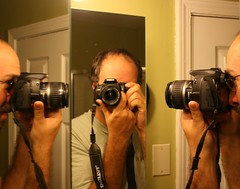And, as promised in my final change jar post, I transferred the Coinstar number into an Amazon gift certificate, and went shopping. The amount I got from the change jar was just enough to get my dream Digital SLR camera, the Canon 400D, aka the Digital Rebel XTi.
It arrived yesterday, and, after fishing a spare CF card out of my parts bin, I’m happily taking pictures with it.
It has pointed out, however, that my Camera-Fu is seriously lacking, and I need to do some studying up. This camera has more settings, more fiddlings, more details than anything I’ve worked with before I have a lot to learn.
I took this picture last night while playing around with the mirrors a bit (was looking to take a picture of the camera itself, but ended up with this arrangement.)
One thing I hadn’t really considered. The images on the camera are something like 11meg each, and Flickr has an upload limit of 10meg. It means I can’t save the raw images I take directly to Flickr as my primary archive. I need to reconsider how I store / sort / upload pictures now.
But… Yay new camera!!!

That’s a neat shot. Yay camera!
I got my new one last week on Thursday (?). I should get the photos from VT off of it and post about new cameraness too.
Congrats! If you ever wanna geek on cameras, lemme know, k? I’ve had my D40 since last December, and it’s so fun to play with!
Yes, I’m at my 200 photo limit on my free flickr. And I don’t want to put all my artsy shots on my online photo album. I’m thinking of using the web upload tools on the latest Picasa, which allows you to store vast quantities of files! I haven’t played around with it too much, but when I do, I’ll let ya know!
Have fun! Make with the clicky!
“It means I can’t save the raw images I take directly to Flickr as my primary archive.”
I don’t think flickr supports RAW anyway.
I generally convert all my RAWs to jpg right off the bat.
Mrs. TDH sez:
I don’t think flickr supports RAW anyway. I generally convert all my RAWs to jpg right off the bat.
Hmm, this is part of my edumification going into DSLRs. I used ‘raw’ there as an adjective – meaning images I haven’t manipulated or fiddled with yet. The camera can shoot in JPG mode, thereby compressing on the fly. The disadvantage is you’ve gone into “lossy” mode, and as I’ve been learning, it’s less about ‘pure’ imagery (“NO LOSS!!!”), and more about keeping as much data about the original picture as possible for use in post-processing.
Since my old camera was always running in JPG mode, this wasn’t an issue, and the image I uploaded to Flickr was an exact copy of the image I shot. If I wanted to do processing later, I had a copy on Flickr. Now, though, I can’t do that, so what’s my course? Do I… keep a local archive of my ‘master’ images, and publish only post-processed / compressed images? Do I shoot in JPG, and run the risk of not having a ‘full’ image to work with? Do i look at a different image hosting service?
For my initial work, I will most likely go JPG immediately, until I get to the point where I find myself wishing for more detailed image depth and information for post-processing, and continue with using Flickr as my photo archive.
Yay for a new camera! I know you’ve been wanting this for a while. Happy photographing!
Here are some tips:
1. If you don’t have a filter already, get one. Your lens needs protection. If nothing else, just use a Sky 1A. I have a rotating polarizing filter. Filters are way cheaper than lenses.
2. Edit edit edit. Take lots and lots of shots, but only pick out your very very best to save. It’s a good practice to critique your photos and pick the very best. Also,there are lots of places online where you can get constructive criticisms of your photos. Be brutal.
3. I always do post production on any photo I am saving ( I use Photoshop; I know very little about using it, but even the basics of cropping, color, contrast and brightness levels will improve the finished product). Yes, save your originals, then save your edited work under a different name and publish those. That way you can always go back and fart around with the original. RAW is a format that your camera can save your pictures in. My camera came with a booklet that explained how to work with RAW vs. JPG format.
And of course, just learn about the basics of a good photograph. That information is everywhere. My rules of thumb include:
Have a center of focus.
Make sure you have a full range of exposure in each photo from almost pure white light to blackest black shadow.
Fill the frame.
And take lots of pictures!